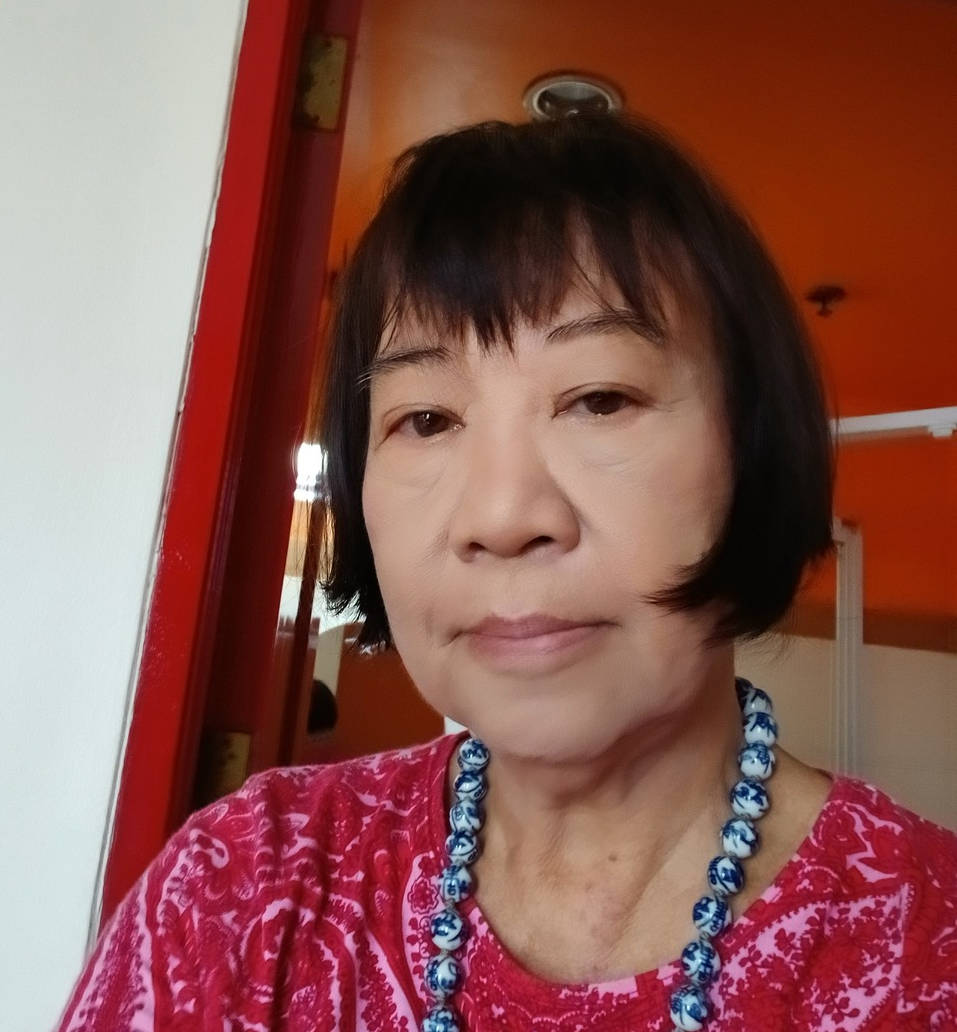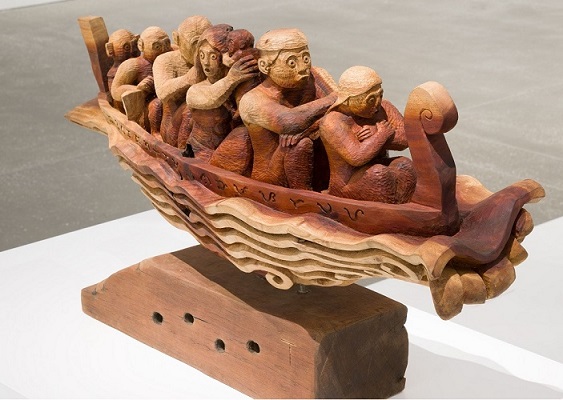
The 11th Asia Pacific Triennial of Contemporary Arts features 70 artists, collectives, and projects from more than 30 countries at Queensland Art Gallery-Gallery of Modern Art (QAGOMA), Brisbane, Australia until 27 April 2025. For the first time, this Triennial focuses on minority and diaspora cultures and “the collective, performative, and community-driven modes of artmaking” that thrive in the region.
The Philippine focus is on Mindanao and the Sulu Archipelago: Roots and Currents, exploring the contemporary art of Mindanao, Sulu, Tawi-tawi, and Basilan, and co-curated by Abraham Ambo Garcia Jr, Al Nezzar-Ali, and Emi Englis.
Amidst Mindanao’s rich culture, its artists are often unrecognized and marginalized by isolation and distance (from the Manila-centric art world), and perceptions of instability and danger made much more complicated by indigenous status and Islamic culture.
Artwork from the indigenous, Bangsamoro, and settler-root peoples range from textiles, woodcarving, and ceremonial baskets together with paintings, videos, and sculpture. All express local stories, indigenous knowledge, cultural heritage, and innovation —raising awareness of the region’s wealth and heritage and the determination to sustain their distinct artistic identities.
Painting
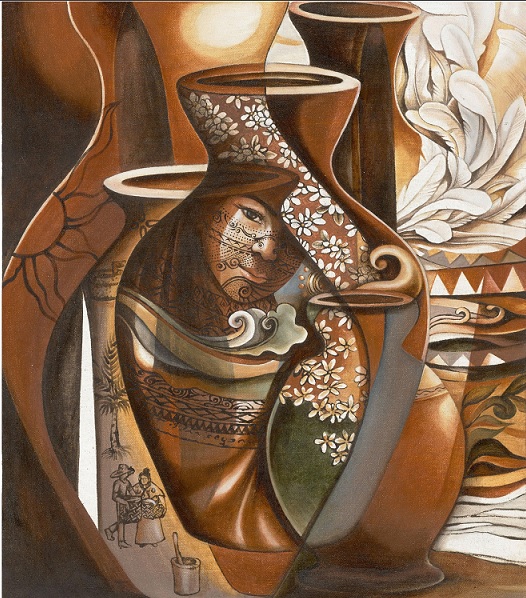
Salima Saway Agraan (b.1988, Songco, Bukidnon). The youngest daughter of Datu Kinulintang, former leader of the Talaandig people in Bukidnon, she is known for soil paintings. She uses ochres from the soil of her ancestral lands in Bukidnon, as seen in her Cultural Fragility series of paintings.
Her works draw on Talaaandig epic chants, myths, and indigenous knowledge. Advocating for the preservation of the indigenuous way of life and land stewardship, her use of the soil is a reminder that the earth gives and nurtures life. “All of us step on it, yet all of us are able to stand up because of it.”
Textiles
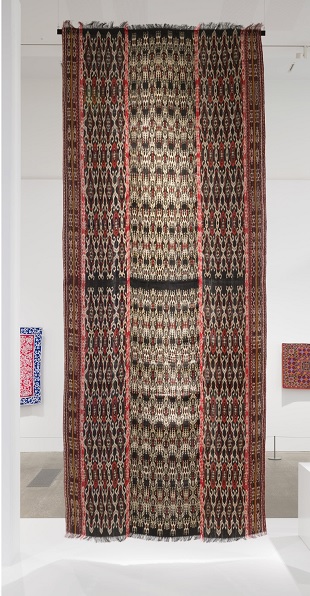
Weaving remains the cultural bedrock of the indigenous peoples across Mindanao and Sulu.
Yab Trulan Man (b.1964, Klubi, Lake Sebu, Cotabato). She is well known for her Tnalak textiles, woven from abaca fibers. Tnalak textiles play an essential role in Tboli culture, especially in ritual and ceremonial practices. Man’s Yê Kumù is one of the most revered type of Tnalak, used in wedding ceremonies.
Using a backstrap loom with ikat-dyeing technique, Tnalak textiles use three colors of white, red, and black-brown. White is the natural color of the abaca; red is from the roots of the loko tree and black-brown from the leaves of the knalum tree. Animal motifs include kleng (crab), sawo (python skin), klung (shield), and tofi (frog). The fabrics are polished with a cowrie shell for a smooth sheen.
Known as dream weavers, Tboli weavers are said to receive new motifs in their dreams from Fu Dalu, the goddess of abaca.
Habul tyahian
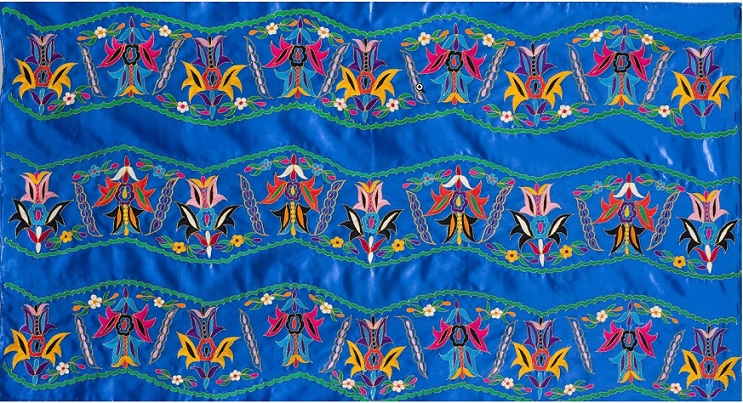
Several artists of Habul tyahian are included and one of them is Krisher Bayani Appay (b. 1995, Lawm Suwah,Parang, Sulu). A Tausug, she is known for Habul Tyahian, a distinctive Tausug art form that uses hand-embroidered satin fabrics that show Muslim belief and values in its motifs. Appay’s work features cerulean satin embroidered with a three-line floral motif.
On colorful satin, embroidered motifs form linear patterns of three to five lines using ukkil, a distinct visual language of vegetal and flowing, organic forms with its own rules and symbolism. Ukkil also reflects Islamic principles of symmetry that symbolize the interconnectedness and continuity of the universe.
Common motifs include flowers such as the kayapo (lotus considered sacred and a connection to the divine); nayaga (dragons or serpents), sulam (leaves), and bagun-bagun (vines).
Pis syabit
Harija Alaw (b. 1968) and Nadia Allih. (b .1984) Guimba Lagasan, Parang, Sulu). Pis syabit is worn by Tausug men as headcloth. It represents a mixture of cultures, trade, and religion in the Mindanao region, with elements of Islamic, Hindu, and Buddhist influences.
“Pis” refers to the pattern and “syabit” to the hook or tapestry technique used to create intricate geometric patterns bound by principles of symmetry. Made of cotton, silk, or polyester on a backstrap loom, its motifs are passed between mothers and daughters, with designs inspired by nature and daily life such as fish, dragonflies, jackfruit, and houses.
Taguri
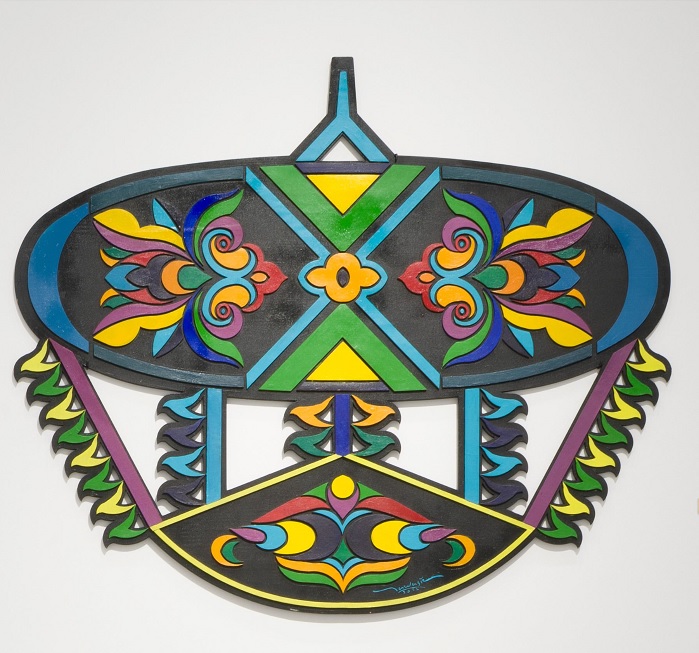
Rameer Tawasil (1969-2023). A Tausug, his family was forced to relocate to Zamboanga City when war broke out between government troops and the MNLF in Sulu in 1974. Aside from painting, Tawasil is known for his traditional Taguri or kites, a beloved preoccupation of the Tausug.
Tawasil’s kites are inspired by the Royal Kites of Sulu during the era of the Sulu Sultanate. Formed of carved ukkil, they convey pride in Tausug culture and heritage. Ukkil or arabesque motif is an art form that combines scroll and plant-like designs and curvilinear forms representing the naga, dragon or serpent.
Tutup and Tondaan
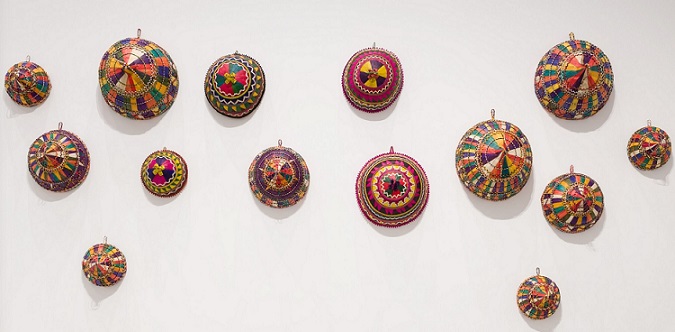
Rhudsia Jamih Mohammad (b. 1959, Nunukan, Sibutu, Tawi-tawi). A Sama artist, she makes Tutup, woven food covers in vibrant colors, and ceremonial significance. They are adorned with motifs inspired by Sama seafaring tradition, including the five-pointed star (bintang), zigzags that represent lightning, and undulating lines for waves.
Mohammad also creates miniature Tondaan, intricately detailed boats with colourful sails that reflects the Sama people’s maritime heritage and boat craftsmanship.
Check this Triennial: https://www.qagoma.qld.gov.au/exhibition/the-11th-asia-pacific-triennial-of-contemporary-art-apt11

